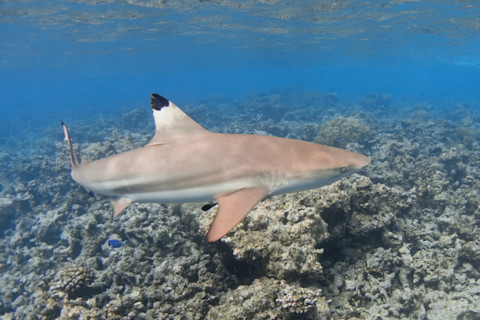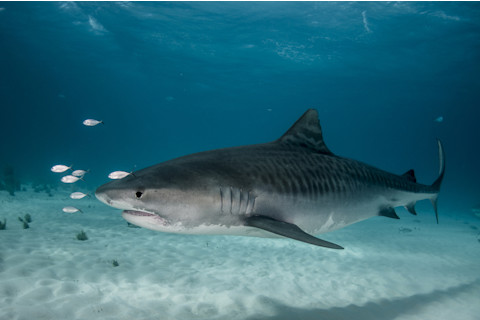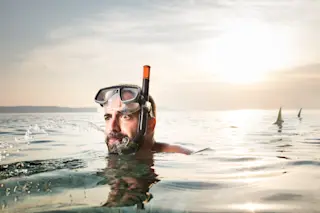This article was originally published on March 28, 2023.
When a surfer paddles out to catch a wave, their silhouette creates an image of a shark swimming below. Against a bright sky in the water, a human could resemble the body of a seal or a shark's favorite prey.
We've commonly heard that this is why sharks attack humans. Recently, however, a new study challenges this theory.
Eric Clua, a marine biologist and veterinary doctor based in French Polynesia, and Carl Meyer, a biologist at the University of Hawai’i, published a paper in Behaviour that provides an alternative answer to shark attacks: personality and upbringing.
How Often Do Sharks Attack Humans?
The most important thing to know about shark attacks is that they almost never happen. Fewer than 100 unprovoked bites are reported annually, and six people die from them worldwide in an average year. Compare that to the benchmark of unlikely occurrences being struck by lightning, which kills about 28 people each year in the U.S. alone.
“They get a lot of attention by journalists,” says Clua, referring to shark bites and the media frenzy they can sometimes create. “But if you look at the data, there are much fewer bites from sharks than from crocodiles, dogs, etc.”
Why Do Sharks Attack Humans?
H. David Baldridge first suggested the scientific theory of sharks mistaking humans for seals, aka the mistaken identity theory, but used cautious language to describe the idea.
Baldridge wrote in a 1973 technical report that it was “certainly not beyond reason that a person so clad [in a wetsuit] might appear to a shark to resemble a seal or other marine animals upon which the shark might be feeding.”
Read More: Studying Shark Brains
Debunking the Mistaken Identity Theory

(Credit: vkilikov/Shuterstock)
vkilikov/Shuterstock
The mistaken identity theory got relatively little public attention, until another paper on white shark hunting behavior, 10 years later, brought the idea into the scientific mainstream.
From there, it has been repeated in both scientific and popular sources, sometimes without the nuance and caveats of Baldridge’s original writing. But Clua and Meyer say the science of mistaken identity is anything but settled.
How Sharks Hunt
Their case against Baldridge’s theory rests on a few different pieces of evidence. One is the array of senses that a shark uses against its potential prey. Clua says that most studies of shark-human interaction have centered mostly on vision and smell.
“Those are only two senses, and there are two others that are critical from my perspective: sound and mechanoreception,” he says, referring to sharks’ ability to sense movement in the water. “I strongly believe that these two senses are actually more important than vision and olfaction.”
What Sharks Eat
Another piece of evidence: Many of the species of shark that most often bite people do not even eat seals or other marine mammals. Blacktip sharks, for example, account for over 15 percent of all shark bites worldwide, and they eat mostly small or medium-sized fish.
Even if a shark in murky water might confuse a human surfer with a seal, it seems less realistic that they would mix us up with a mackerel or flounder. On the topic of visibility, Baldridge’s theory seems to suggest that there would be more bites in murky water than in clear conditions. In fact, most shark bites happen in clear water.
But is there a more likely explanation?
Read More: What’s Unique About the Blue Shark?
Shark Characteristics

A tiger shark swimming (Credit: Shane Gross/Shutterstock)
Shane Gross/Shutterstock
Clua and Meyer support an alternative theory based on shark characteristics called the prey exploration hypothesis. Previous studies have shown that sharks have individual personality traits, including different degrees of boldness or curiosity.
Lacking parental care, sharks must learn about their environments and potential prey themselves, and they do this by exploring, often with their mouths. Put simply, they may not think we are seals. They don’t know what we are, and the boldest, most curious ones occasionally bite us to find out.
Looking Into Shark Eyes
When researchers simulated the way a white shark’s retinas would interpret the silhouette of a surfer in a paper published in the Journal of the Royal Society Interface in 2021, they found images visually similar to a seal or sea lion.
In Clua and Meyer’s paper, however, they argue that the findings of this study, while technically impressive, could be interpreted to support either theory. The fact that younger white sharks are more likely to bite humans than older ones, which the authors of the 2021 paper claim, also supports their prey exploration hypothesis. To them, a younger shark is likely to be less experienced with humans, leading to the rare, exploratory bite.
Clua has simple advice for anyone worried about shark encounters, despite how incredibly rare bites are in the wild. “If you are diving, swimming, surfing, keep doing what you’re doing. But never do it alone – for two reasons. First of all, by being two, you can change the shark’s decision-making, because it’s a different choice to bite a single prey vs. biting prey that are together. And, if the shark does make that decision, the second person is there to help.”
Read More: Almost 20 Million Years Ago, Sharks Nearly Went Extinct














